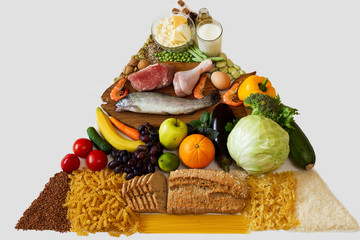Food Pyramid Myth

Food Pyramid
Food Pyramid Myth
I can remember being in grade school studying food and nutrition in the sixth grade. It wasn’t a term-long class, just a few days of informal discussion along with big photos of apples, grains, milk and meat. My teacher showed us the large pyramid with the food items, and tried to explain to us how much of each particular food group we should eat. It didn’t make much sense to me, and I never really paid much attention to the pyramid until I became older.
Over the years, the food pyramid (outlined by the government) has made many changes to its food proportion diagram. They have increased certain food items, while decreasing others. It’s my opinion, first of all, that the US government shouldn’t be providing the public with food guidelines. Everyone has different dietary requirements, and should make these decisions on an individual basis. Also, we know who subsidizes the farming industry; the government. I’m not trying to make this a political argument, but this is a hard point to ignore.
The new Food Pyramid as outlined by the USDA doesn’t give specific proportions and quantities. The pyramid of old suggested specific servings of each food item. For example, the old pyramid suggested 6-11 servings of bread, cereal, rice and pastas. The suggested serving size for fruit was 2-4, and vegetables were, 3-5 servings. Milk, yogurt and cheese suggested serving sizes were between 3 and five servings a day, and meat fish and poultry were between 2-3 servings. Fats and oils were suggested to be used “sparingly.” Now, remember, this was the old food pyramid, but it was only reconfigured five years ago.
So, how much of what should we eat? That’s a difficult question to answer, because everyone has different dietary needs. I’m going to outline a non-specific guide; remember this is merely a guide- you’ll have to fill in the gaps as you see fit. *Before making changes to your diet consult your physician.
I will start, in order as outlined in the current food pyramid making changes and suggestions.
Grains:
Grains are good for your body; they provide essential nutrients such as iron, and fiber. These types of food are good in moderation. If you want some pasta or bread, make sure they are made with whole grains. Regular pastas and breads made with white flour increase glucose (sugar) levels in the body triggering the pancreas to release insulin. Increased levels of insulin can lead to diabetes and high cholesterol. Stay away from bleached flours as well; they’ve been stripped of nutrients. Two servings a day of whole grains, of a few ounces each, should be plenty.
Vegetables:
Eat lots of veggies, as many green leafy kinds too, they contain fiber and calcium. Eat corn in moderation, it’s loaded with sugar and has almost no nutritional benefits. Choose colorful vegetables, they have a wide variety of minerals and nutrients. Avocados have monounsaturated fats (more on that later) which are good for you, but they’re also loaded with calories- eat them in small portions. Try to alternate your vegetable selections. There are so many to choose from, enjoy a variety and try new cooking techniques to keep things fresh! Six servings a day of vegetables is a good place to start.
Fruits:
Fruits also promote health; they have high levels of vitamin C, as well as many other nutrients. There are currently studies being done that suggest pomegranates and blueberries can ward of certain types of cancers, and promote prostate health. Antioxidant rich kiwis, raspberries and strawberries can delay premature cell degeneration and prolong a youthful appearance. Remember, fruits contain a lot of sugar, so don’t over-indulge. Although bananas are potassium-rich, they can also pack on the pounds! Try having four to five servings a day of fresh fruit.
Milk:
You’re not going to like what I have to say here. Sure, milk is good for strong bones, healthy teeth, etc., but how much should we really be drinking? Figure this: we’re the only mammals on the planet that continue to consume milk after we’ve been weaned. How many adults do you know that develop milk/dairy allergies when they become older? The answer is probably many, that’s because our bodies aren’t designed to break down the enzymes in dairy products as we age. I’m not suggesting that you cut out dairy completely, just decrease the amount you are currently consuming. There are other ways to get your calcium fix; try adding a supplement, or eating more green leafy vegetables. Furthermore, try considering having 1% milk instead of skim. The fats found in milk/dairy are there for a reason- they aid in digestion and help metabolize proteins, thus ensuring the absorption of calcium and vitamin D into the body. Have a few pieces of cheese from time to time, just don’t over-do it. One to two servings a day should be plenty.
Oils:
Everyone is afraid of oils and fat, try not to be. The bad fats are saturated or hydrogenated. Any type of fat that is solid room temperature should be used in moderation, or even avoided. If you’re pan-frying food, try some monounsaturated fats, like olive oil. All fats/oils are packed with calories that pack on pounds. Take time to educate yourself on what types of fats to use, it’s important to understand the role that they play in metabolism. For example, fats are an important factor in brain function.
Meats and Beans:
Meat, in my opinion, is the best source of protein and iron. Beans and legumes also have proteins, just not as much as meat. Proteins are needed to repair muscles and bones, and aid in the healing process. Beef, pork, chicken, and turkey are all good choices. Try finding a local marked that sells antibiotic-free poultry or game, it’s much better for you. Hormone-free beef and poultry are also recommended. Eggs are a great source of protein; they also don’t have a reputation anymore- one egg a day is a good amount. Fish has omega-3 fatty acids. These fatty acids provide good cholesterol (HDL) and aid in heart, and overall health. Farm raised fish aren’t recommended. These farmed fish swim around in netted pools that are filled with chemicals and often breed disease. Choose fish that has been pulled from the ocean, the deeper the better. Ask your fish monger what they suggest- also ask him/her what is fresh, and when it was received. Four servings a week, of four to six ounces a piece is recommended.
Summary:
The Europeans have the right idea- they eat frequent meals, and smaller portions. They also consume red wine with almost every meal. Although they eat high-fat foods, they almost always have lower cholesterols levels, and enjoy a healthier life. Americans tend to eat three large calorie-dense meals. Frequent, smaller meals provide a sustained, moderate insulin release. This controlled release provides the body with a continual energy level, and lower triglyceride readings.
Please remember that the suggestion I have made here are merely that; proposals to live a healthier, longer life. Make adjustments to your diet/lifestyle that are right for you, and remember to consult a professional beforehand.
Chef Chuck Kerber
chuck@cooksandeats.com






 in <b>/var/www/vhosts/cooksandeats.com/httpdocs/wp-content/themes/CooksandEats/sidebar.php</b> on line <b>1</b><br />
/wp-content/themes/CooksandEats/images/side-logo.png)



 in <b>/var/www/vhosts/cooksandeats.com/httpdocs/wp-content/themes/CooksandEats/footer.php</b> on line <b>13</b><br />
/wp-content/themes/CooksandEats/images/back-to-top.png)
Awesome!! Thank you!!
I love this site. Always a lively discussion, fantastic news and great content. Please keep it up.